
Choosing a Durable Gemstone
We feel that a better understanding of the factors impacting a gemstone's durability is important to help our clients choose the best gem for the jewelry they plan to set it in. As a general guideline, the more wear and tear the gem is likely to see in jewelry the more durable it should be. An engagement ring for example sees far more wear and tear than an occasional wear ring, while a pendant is usually super well protected on the neck. For this reason a much more fragile gem can be used relatively safely in a pendant. While we try to list the hardness of each gem in our online catalog durability isn't only a question of hardness, there are other factors that come into play as well. To explain these gemstone durability factors we asked Renée Newman who is an author of multiple books on gems to write the article below to outline all the different considerations.
Gemstone Durability Factors
Diamond is the hardest natural gem, yet it can chip and split. For example, John's grandmother broke her 3-carat diamond while washing dishes by accidentally hitting it against the side of a stainless-steel sink. That happened because diamonds have four directions of perfect cleavage, which is the ability for a mineral to split along flat crystal planes where the atomic bonding is weak. A gemstone may have one or more directions of cleavage, which are described as perfect (almost perfectly smooth), distinct, good, fair or poor.
When choosing and caring for gems you should consider the following durability factors:
Hardness: the resistance of a gem to scratching and abrasion. This can be classified using the Mohs scale of hardness which is based on the ability of a harder mineral to scratch a softer material. It was created by Friedrich Mohs in 1812.

|
Diamond Mohs hardness of 10 |
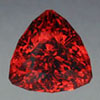
|
Garnet Mohs hardness of 6.5-7.5 (Depending on variety.) |
|

|
Sapphire (and Ruby) Mohs hardness of 9 |

|
Tanzanite Mohs hardness 6-7 |
|
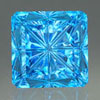
|
Topaz Mohs hardness of 8 |
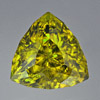
|
Sphene Mohs hardness 5-5.5 |
|

|
Aquamarine (And others of the Beryl family) Mohs hardness 7.5-8 |

|
Apatite Mohs hardness 5 |
|

|
Tourmaline Mohs hardness 7-7.5 |

|
Rhodochrosite Mohs hardness 4 |
|
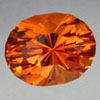
|
Quartz family (Citrine, Amethyst, etc.) Mohs hardness of 7 |
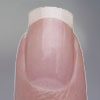
|
Your fingernail Mohs hardness of about 2.5 |
The Mohs hardness scale rates the relative hardness of minerals with numbers from 1 to 10. The 10 rating of a diamond is the highest and the 1 of talc is the lowest. The intervals between numbers on the scale are not equal, especially between 9 and 10. Even though ruby and sapphire (corundum) rate a 9, a diamond is many times harder. Chrysoberyl is the next hardest gem (Mohs hardness of 8.5) followed by topaz and spinel, which have a Mohs hardness of 8. Many gems including diamond even have a directional hardness where one direction or surface is harder than another.
Toughness: the resistance of a gem to breaking, chipping or cracking. This is a different property than hardness. Jade is a relatively soft gem material (6-7), yet it has the potential of being the toughest gem when it is very pure and free of fractures. As another tough gem, sapphires are a popular choice for engagement rings because they have a high resistance to scratching and an excellent toughness rating. In addition, they come in a wide range of colors and often have a high clarity.
Treatments can affect the toughness of gemstones. Glass-filled rubies (aka composite rubies) can easily chip and crack and may break into pieces if they come into contact with a jeweler's torch. John does not sell glass-filled rubies or sapphires, but you can learn more about that kind of treatment here.

Blue Topaz Rough
A photo of the flat surface left after a piece of topaz has broken along the cleavage plane. Topaz and spinel have the same Mohs hardness of 8. However, the GIA Gem Reference Guide rates the toughness of spinel as good but that of topaz as poor because of its perfect cleavage. Other gems with perfect cleavage include sunstone, moonstone and tanzanite. Chrysoberyl, on the other hand, has no cleavage and is a good gem for daily wear because of its excellent toughness and Mohs hardness of 8.5.
Photo credit: Arya Akhavan
Chemical Resistance: The resistance to chemicals varies from one gem to another. Diamond, chrysoberyl, garnet, spinel and tourmaline resist all chemicals, Sapphires resist almost all chemicals, but goldsmiths should exercise care when working on them as some solutions containing borax may etch the surface of the stone when the solution is heated. Lapis, pearls, peridot and turquoise are especially sensitive to acids.
Chemicals can remove the fillers in fractured-filled gems, thereby decreasing their clarity and sometimes their color. Emeralds are almost always fracture-filled and it's not uncommon for rubies to be oiled to improve their clarity (both these enhancements need to be disclosed to the buyer, John Dyer Gems does not sell ruby enhanced with oil and all clarity enhanced emerald they do disclose, more info on that can be found here https://www.johndyergems.com/info-about-gemstone-treatments-and-enhancements.html ), if you are not sure your gem is unenhanced it's best not to clean them in ultrasonic cleaners because the vibrations and cleaning solutions can gradually remove the oil or resin used in the clarity enhancement process.
Avoid using chemical cleaners on dyed gems because the chemicals can remove or change their color. One of the advantages of buying gems from John is that he discloses all treatments and many of his gems are untreated. None of his gems are dyed.
Temperature Resistance: High heat and sudden temperature changes can cause fracturing in gems such as garnets, peridot, quartz, sunstone, tanzanite, topaz and tourmaline. Therefore, these stones should not be steam cleaned, heated with a torch during jewelry repair or placed near heating devices.
Color Stability: Some gems such as kunzite, morganite, pearls, rose quartz and irradiated yellow sapphire can fade or change color over time when exposed to sunlight, UV lights (such as tanning beds or nail salon lights) or strong spotlights. Amethyst and citrine can also lose their color but it's more stable than that of rose quartz and kunzite. Do not place any of these gems in a sunny window display or wear them while sunbathing if you want them to retain their depth of color. (Short periods of exposure when not soaked in the sun will not usually impact amethyst and citrine color significantly as they are more resistant to change than kunzite.)
Gems, like cars, can get scratched and dull looking over time. However, as long as they have only been abraded, they can be repolished and made to look like new. For those who want to use some of the less hard or durable gems in a ring, one advantage some of these gem varieties have is that they are often more affordable and can more easily be replaced at a relatively low cost if damaged. This potential need to replace a gem in the future can be factored into the initial choice of which gem you buy. Especially for ring wear a good general rule is that the more often the gem is to be worn the more durable it should be.
If you'd like to decrease the need for refurbishing your gems:
By Renée Newman GG, author of the Gemstone Buying Guide: How to Evaluate, Identify, Select & Care for Colored Gems. More information about Renée and her books is available at www.ReneeNewman.com